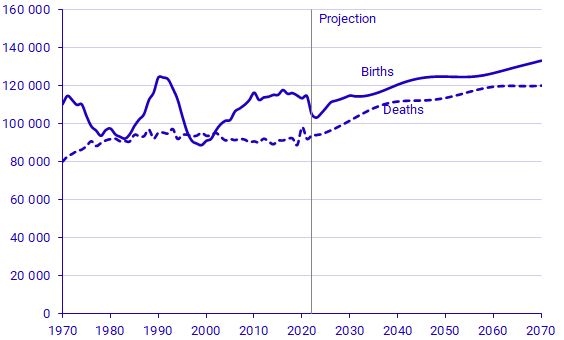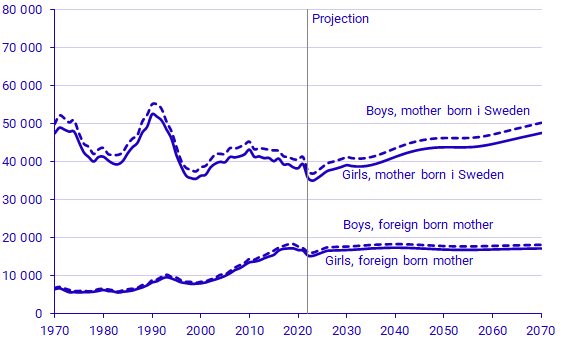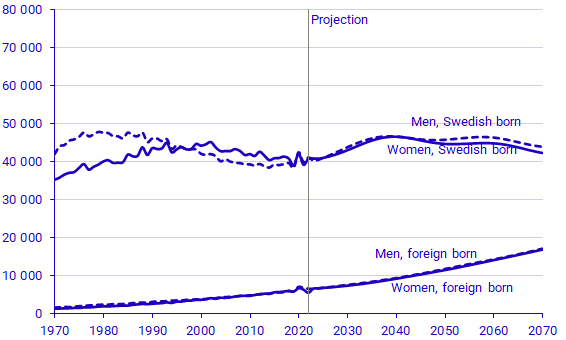Births and deaths 1970–2022 and projection 2023–2070
Births and deaths 1970–2022 and projection 2023–2070

Births by sex and country of birth 1970–2022 and projection 2023–2070

Deaths by sex and country of birth 1970–2022 and projection 2023–2070

Comments
The number of births in Sweden has varied sharply over time. This is partly due to that during certain periods there are more women and during some periods fewer women in childbearing ages. It also depends on that women and men adapt their childbearing intentions, taking into account what has been optimal from an economic or practical point of view. During the economic downturn in the 1990s, many chose to continue to higher education and the number of births decreased. In the near future the number of births are expected to increase, due to the large cohorts born in the beginning of the 1990s who will be in the most frequent childbearing ages.
As the number of foreign born persons increases in Sweden, the number of children born with a foreign born mother also increases. During the 1970s, more than 10 percent of the newborn children had a foreign born mother. The proportion has increased and, in 2022, 30 percent of the newborn had a mother born in a country other than Sweden. This proportion will remain until the mid-2040s. Towards the end of the projection period just over one-fourth of the newborn are expected to have a foreign born mother.
There are more boys than girls born each year and in the projection we expect that 106 boys per 100 girls are born. It is the same relationship between the sexes as the average for the period 1960–2020.
Until the end of the 1990s, more men died than women each year in Sweden. This pattern has reversed from the early 2000s to 2019 and the number of deceased women was larger than that of deceased men each year. This reversal can be explained by the fact that mortality rates have declined faster for men than for women. But the years 2020 and 2021 were exceptions, a somewhat larger number of men than women died these years. The number of deceased persons has for recent years remained at just over 90 000 cases per year, but in 2020 it was 98 000. This number is expected to increase when the large cohorts born in the 1940s reaches older ages.
Previously, the proportion of foreign born persons in the older ages was small and therefore the number of deceased people who were born abroad has been relatively small. The majority of immigrants are in ages 20 to 30. As they grow older, the number of deaths of persons born abroad will also increase. Only a relatively small percentage of those who died in 1970 were foreign born individuals and in 2022 this figure was 13 percent. It is estimated that just over one-fourth of the deceased in 2070 will be foreign born persons.
In the short term, this projection can be regarded as a population forecast. In the long term, the projection should be regarded as precisely a projection of the population in the case that current behaviour and trends continue in the future. Furthermore, an assumption is made that regulations that apply today will continue to apply throughout the projection period. Already in the short term, changes in society or in the world around us may mean that projection conditions will change.